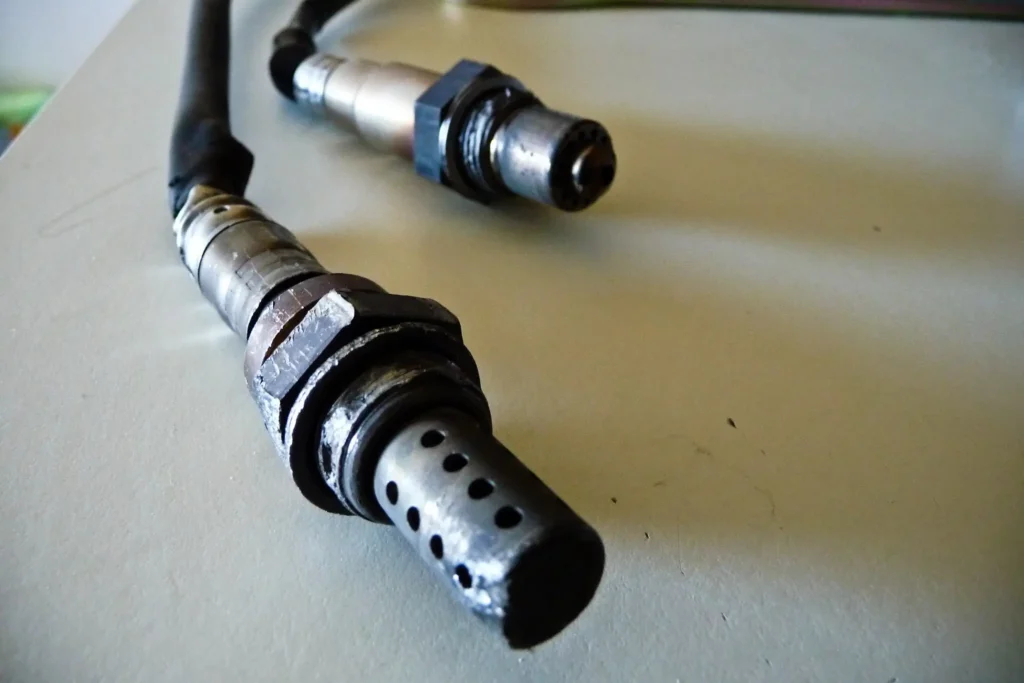A faulty oxygen sensor (O2 sensor) is one of the most common causes of poor gas mileage in vehicles. But how exactly does a malfunctioning O2 sensor lead to reduced fuel efficiency? In this comprehensive guide, we’ll examine the role of the oxygen sensor, the symptoms of a failing unit, and how it can significantly impact your gas mileage.
What is an O2 Sensor and What Does it Do?
The oxygen sensor, also known as the O2 sensor or lambda sensor, is an integral emissions component found on all modern vehicles with internal combustion engines. It is located in the vehicle’s exhaust system, either before or after the catalytic converter.
The primary function of the O2 sensor is to monitor the oxygen levels in the exhaust stream. It detects whether the air-fuel mixture being burned in the engine is rich (too much fuel) or lean (too little fuel).
This information is communicated to the powertrain control module (PCM) or engine control unit (ECU). The PCM uses this data to make adjustments to the air-fuel mixture, maintaining the optimal ratio for efficient combustion.
Maintaining the perfect air-fuel mix not only maximizes engine performance and fuel economy, it also helps reduce harmful emissions. The O2 sensor has a direct impact on fuel efficiency and emissions.
What Happens When You Have a Faulty O2 Sensor?
When an O2 sensor fails or becomes contaminated, several issues can arise:
- Incorrect data to PCM – With a malfunctioning O2 sensor, the data sent to the PCM will be incorrect. This leads to improper fuel trim adjustments by the PCM.
- Rich or lean mixture – Faulty readings can cause the engine to run too rich or too lean. A rich condition wastes fuel, while a lean mixture reduces power.
- Poor drivability – Engine performance problems like surging, hesitation, or rough idling can occur. Misfiring and stalling are also common symptoms.
- Catalytic converter damage – Excessively rich or lean mixtures can lead to converter overheating and meltdown.
- Increased emissions – Precise fuel control is needed to maintain low emissions. Erroneous data from a bad O2 sensor will increase emissions.

All of these issues stemming from a faulty oxygen sensor can lower fuel efficiency. When the engine is unable to run at peak efficiency, gas mileage suffers.
Will a Bad O2 Sensor Cause Bad Gas Mileage?
Absolutely. An oxygen sensor that is no longer functioning properly or sending accurate data to the PCM will almost certainly cause a noticeable drop in your vehicle’s fuel economy.
Here’s a more in-depth look at how a faulty O2 sensor negatively impacts MPG:
- Rich mixture – The most common result of a malfunctioning O2 sensor is a rich air-fuel mixture. Too much fuel in the mix will dramatically reduce fuel efficiency. Unburnt fuel gets expelled as emissions.
- Lean mixture – While not as common, a defective O2 can also cause a lean mixture. Lean combustion increases resistance in the engine, forcing it to work harder, using more fuel.
- Increased fuel consumption – Due to improper combustion, more fuel is required to maintain performance. Engine efficiency and economy suffer.
- Misfires – Misfiring cylinders due to poor ignition timing from a bad O2 sensor waste fuel and reduce power and economy.
- Catalytic converter damage – Failure of the converter requires replacement, an expensive repair that further hurts MPG.
- Increased emissions – Higher amounts of unburnt hydrocarbons, carbon monoxide, and other emissions indicate fuel inefficiency.
While the drop in fuel economy will vary depending on engine load and operating conditions, you can expect a substantial MPG reduction, often between 10-20% or more when an O2 sensor is malfunctioning.
What Causes an O2 Sensor to Fail?
Oxygen sensors gradually degrade over time and miles due to normal wear and tear. But there are certain factors that can hasten their demise and lead to premature failure:
- Mileage – Most O2 sensors will need replacement between 60,000-100,000 miles. Upstream sensors generally last longer than downstream units.
- Overheating – Prolonged exposure to excessive exhaust temperatures can damage sensor components.
- Contaminants – Oil ash, fuel additives, coolant, and silicates from air intake debris can coat the sensor and interfere with operation.
- Damage from backfire – Backfiring in the exhaust system can physically harm the ceramic bulb and wiring.
- Electrical faults – Shorts or breaks in O2 sensor wiring leads to failure. Connector and terminal corrosion are common.
- Failed heating element – The sensor relies on its internal heater for accurate operation when cold. Heater failure will cause poor startup performance.
- Lean misfire – Misfiring cylinders dump oxygen into the exhaust stream which may falsely indicate a lean condition to the O2 sensor, leading to failure.
Signs of a Failing O2 Sensor
A failing oxygen sensor produces symptoms that alert drivers of potential issues:
- Check Engine Light – An illuminated check engine light with O2 sensor related fault codes is a clear sign of problems.
- Poor fuel economy – Reduced gas mileage is one of the most common symptoms of a bad O2 sensor.
- Rough idle – Engine misfiring caused by inaccurate sensor readings will produce a fluctuating idle.
- Hesitation or surging – As the PCM struggles to compensate for erroneous O2 data, noticeable drivability issues occur.
- Hard starting – Faulty O2 sensors can cause long cranking times before the engine fires up.
- Failed emissions test – Emissions tests will detect the elevated CO and HC levels that occur with fuel metering problems.
Addressing an O2 sensor problem at the first sign of symptoms will minimize further damage and expense. Procrastinating the needed repair risks catalytic converter failure, which significantly raises the cost.
How Long Can You Drive With a Bad O2 Sensor?
While an oxygen sensor failure is not an immediate threat to the drivability of your vehicle, it’s not recommended to continue driving long term with a malfunctioning unit. Here are some risks associated with postponing repair:
- Increased emissions – Prolonged driving with inaccurate sensor readings will worsen emissions levels. This impacts the environment and fails inspections.
- Lower MPG – Fuel economy will continue to suffer, costing you more money at the pump over time as the sensor problem persists.
- Catalytic converter damage – The longer you operate with a bad O2 sensor, the higher the likelihood of incurring a very costly catalytic converter replacement.
- Failed sensor damage – Driving for too long on a failing O2 sensor may cause internal sensor damage requiring full replacement rather than just repairs.
- Failed engine performance – Ignoring erroneous O2 sensor data can eventually lead to engine performance issues and potential internal engine damage over time.
While you can limp along briefly on a bad O2 sensor in order to get to a repair shop, we recommend fixing the problem as soon as realistically possible.
Other Causes of Reduced Fuel Economy
Certainly a malfunctioning oxygen sensor should be at the top of your list when diagnosing a noticeable decrease in gas mileage. However, don’t overlook some other common causes:
- Dirty air filter – A clogged air filter increases resistance to airflow, choking off the engine.
- Dirty fuel injectors – Restricted injectors force the PCM to increase pulse width to deliver enough fuel.
- Dragging brakes – Brakes that don’t fully disengage waste fuel through heat and resistance.
- Slipping transmission – Automatic transmissions that slip will rev the engine higher than needed.
- Damaged MAF sensor – An inaccurate mass airflow sensor confuses the PCM calculations.
- Thermostat stuck open – Preventing the engine from quickly reaching operating temperature hurts fuel efficiency.
- EGR valve failure – A stuck open EGR valve dilutes the air-fuel mixture, reducing economy.
- Dead O2 sensor – A sensor with no activity at all will trigger an overly rich mixture from the PCM.
- Engine mechanical issues – Problems like bad rings, leaking valves, or compression loss require more fuel to make power.
- Low tire pressures – Under-inflated tires create more rolling resistance which burns extra fuel to overcome.
Don’t forget that driving habits and routine maintenance are also huge factors that determine your vehicle’s fuel efficiency.
Fixing an O2 Sensor Problem
Repairing a faulty oxygen sensor is essential to restoring lost engine performance, emissions compliance, and fuel economy. Here are your options:
- Replacement – For older sensors that have exceeded their lifespan, full replacement is required. Both upstream and downstream O2 sensors should be replaced in pairs. Use quality OE or OEM equivalent parts.
- Cleaning – Special aerosol cleaners are available that can remove contaminants fouling the sensor if the unit still shows some activity. This can restore normal function and extend O2 sensor life.
- Repair – Damaged O2 sensor wiring can sometimes be repaired rather than necessitating complete replacement. Fixing connectors, terminals, and breaks in wiring may resolve sensor codes.
- Tune up – If a dead O2 sensor is accompanied by other ignition issues, a full tune up including spark plugs, wires, filters, etc. is wise. This optimizes function of the new sensor.
Addressing a faulty oxygen sensor promptly minimizes excessive fuel usage. Your vehicle’s performance and fuel efficiency both benefit.
FAQ – O2 Sensor Problems and MPG
Will replacing an O2 sensor improve gas mileage?
Replacing a damaged, dead, or dying O2 sensor will almost always result in a noticeable bump in fuel efficiency, assuming no other problems exist. Restoring proper fuel control and combustion efficiency through a new oxygen sensor allows your engine to maximize MPG.
What are the symptoms of a bad O2 sensor?
Common symptoms exhibited by a malfunctioning O2 sensor include reduced fuel mileage, check engine light illumination, engine misfires, rough idle, hesitation and surging, hard starting difficulty, and failed emissions inspections.
What sensors affect gas mileage?
Some key sensors providing PCM data that influence fuel efficiency are the mass airflow sensor (MAF), manifold absolute pressure (MAP) sensor, throttle position sensor (TPS), camshaft position sensor, and both upstream and downstream oxygen sensors.
Which oxygen sensor is responsible for fuel consumption?
The primary oxygen sensor impacting fuel usage is the upstream sensor mounted before the catalytic converter. This sensor supplies the critical data needed for fuel trim adjustments. Downstream sensors mainly monitor converter efficiency.
Should I replace all 4 O2 sensors at once?
This is usually not necessary. Upstream sensors linked to fuel control typically degrade first. Replacing only faulty ones based on diagnostic trouble codes is the wise strategy. However, if your vehicle has high mileage or you prefer, replacing all simultaneously is an option.
Is it better to clean or replace O2 sensors?
It depends on the sensor’s condition. Cleaning can temporarily restore function of contaminated sensors. But cleaning heavily damaged or dead ones will provide no benefit. Judicious cleaning combined with replacement as needed is the best approach.
The Bottom Line
The humble oxygen sensor has a huge impact on your vehicle’s air-fuel ratio, emissions output, drivability, and fuel efficiency. A check engine light and decreasing MPG are clear indications your O2 sensor may be failing.
The Simple answer to this question “Will a Bad O2 Sensor Cause Bad Gas Mileage?” is Continuing to drive with an inaccurate or dead sensor leads to unnecessary fuel waste and escalating problems. Diagnose and address oxygen sensor issues promptly to restore lost fuel economy while preventing further damage to your emissions system.
With diligent oxygen sensor monitoring and maintenance along with proper operating conditions, your vehicle’s MPG and performance will benefit greatly.





